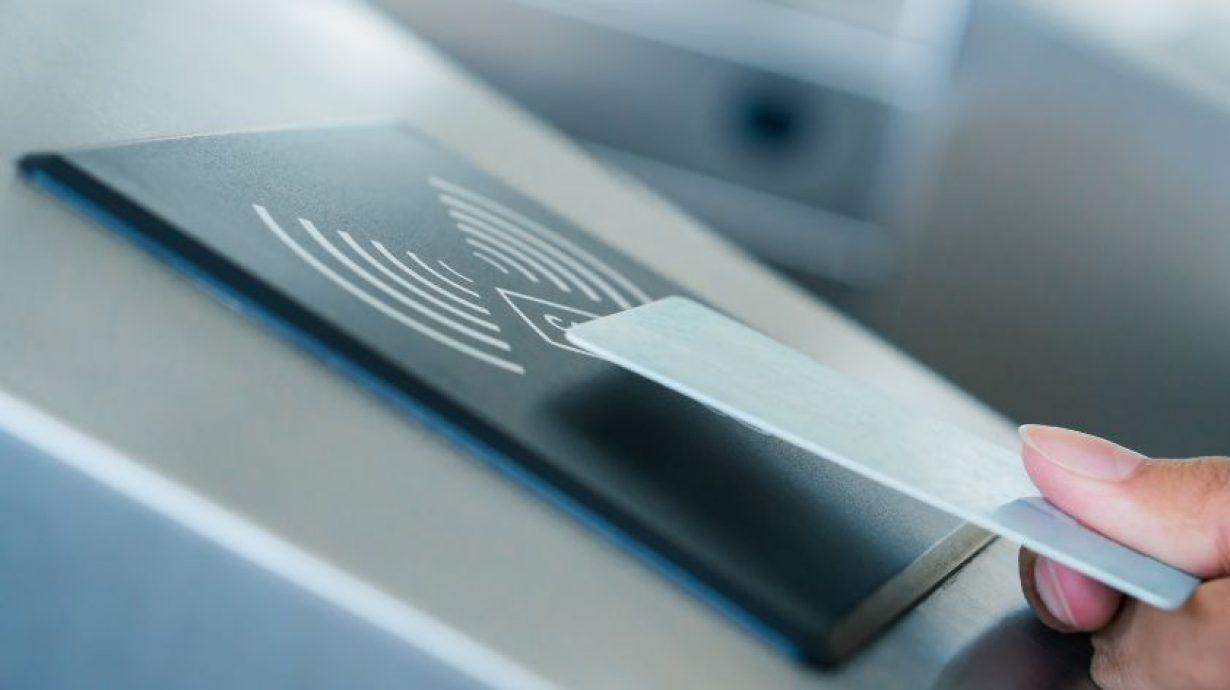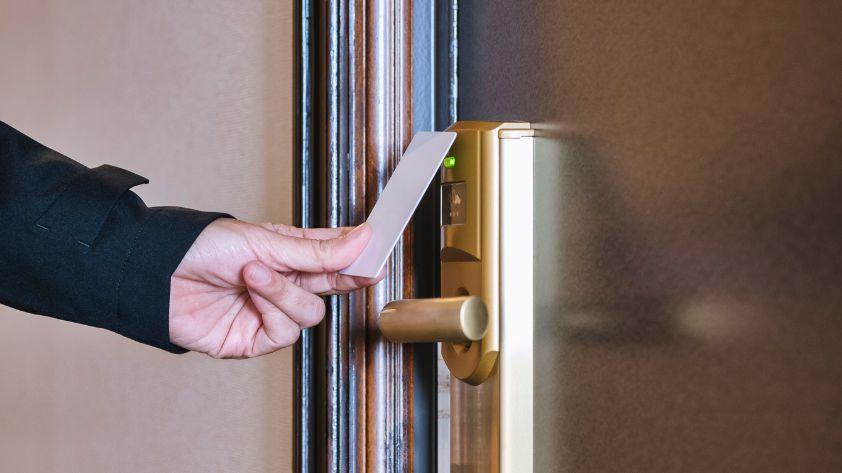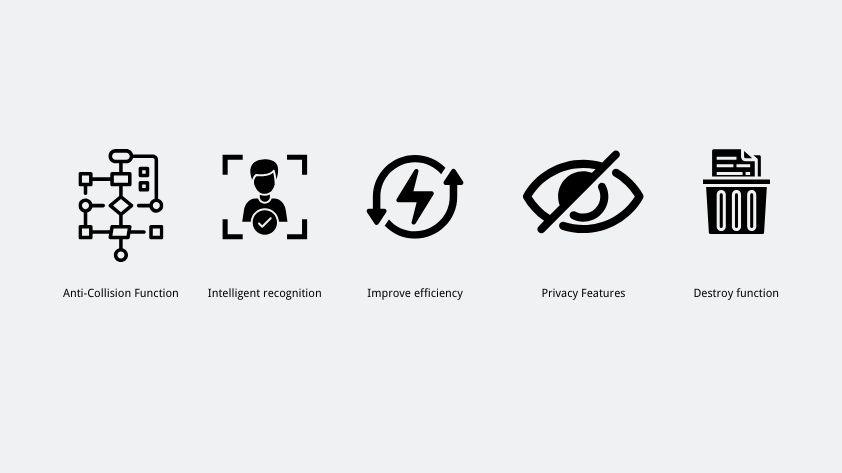
The DNA RFID Card: Revolutionizing Identity Authentication and Access Control
Introduction
With the continuous advancement of digital transformation, identity authentication and access control have become the core elements of security management for enterprises, governments, and various institutions. Traditional methods like passwords and fingerprint recognition have certain limitations in terms of convenience and security, and the introduction of RFID (Radio-frequency identification) technology has brought revolutionary changes to this field. RFID technology offers higher security and convenience through wireless communication and contactless identity verification, especially in access control systems where it can provide real-time and accurate identity recognition.

DNA RFID Card Overview
Basic Functions of DNA RFID Card
The DNA RFID card is an advanced high-frequency (HF) radio frequency identification card designed for high-security applications, especially for identity authentication and access control systems. It has the following basic functions:
- Contactless Data Transmission: The DNA RFID card operates in the 13.56 MHz high-frequency band and utilizes contactless data transmission. This allows users to exchange information without having to physically touch the card to the reading and writing device. Its unique working principle ensures stable operation in various environments and eliminates concerns about physical wear or damage.
- Long-Distance Reading and Writing Capabilities: Unlike traditional low-frequency (LF) or ultra-high frequency (UHF) RFID technologies, the DNA card can read from a distance of up to 1.5 meters. This makes it very suitable for scenarios where fast and long-distance identification is needed, such as access control systems and identity authentication at large events. Importantly, it can function without a line of sight, meaning users don’t have to perfectly align the card with the reader, greatly enhancing convenience and efficiency.
- No Battery Required, Powered by Contact Energy Transmission: The DNA RFID cards require no battery; they are powered by the reader/writer device via radio waves. The card’s built-in antenna transmits energy to it through electromagnetic coupling, allowing it to operate normally without a battery, thereby reducing maintenance costs and extending its service life.
Core Technology
The DNA RFID card not only has basic RFID functions but also incorporates several advanced security technologies, making it an ideal choice for identity authentication and access control. Its core technologies include:
- AES128 Encryption Authentication: Utilizing the AES128 encryption algorithm for tagging and mutual authentication is one of the core security features of the DNA card. AES encryption facilitates two-way authentication between the card and the reader/writer device, ensuring that only authorized devices can interact with the card, effectively preventing forgery and unauthorized access. Each communication is secured by the AES encryption algorithm, safeguarding data transmission from theft or tampering.
- User Memory: The DNA RFID card provides 2048 bits of user memory, divided into multiple blocks (64 blocks of 4 bytes each) that can be flexibly divided and configured as needed. Each memory block has different access rights, supporting customizable read/write permissions to ensure that users at different levels can access different data. For instance, sensitive information can be set to allow only specific users to read or edit it, effectively protecting data security.
- Unique UID and Original Signature: Each DNA RFID card has a unique identifier (UID), acting as the card’s individual “ID card” that cannot be altered, ensuring that every card is unique globally. Furthermore, each card is equipped with a 32-byte original signature based on ECC (elliptic curve cryptography) to verify its authenticity. The original signature maintains data integrity and reliability through an encryption algorithm to prevent card forgery and tampering of card information.

Application of DNA RFID Card in Identity Authentication
Enhanced Security of Identity Authentication
The security authentication function of the DNA RFID card significantly enhances the reliability and security of identity authentication through several advanced technologies, making it particularly suitable for identity authentication in high-risk environments.
Tag Authentication
The DNA RFID card uses the AES128 encryption algorithm to authenticate the tag. Each card is equipped with a unique UID. Through the AES128 encryption authentication mechanism, the system can verify the authenticity of the card, ensuring that only authorized cards can pass the identity authentication process. This tag authentication not only prevents the card from being copied or forged but also effectively resists various attack methods, ensuring the security and reliability of each identity authentication process.
Mutual Authentication Function
Unlike traditional one-way authentication mechanisms, the DNA RFID card supports two-way authentication, which not only verifies the identity of the card but also the access rights of the read-write device. This mutual authentication mechanism ensures that the communication between the card and the reader/writer is bidirectional and trusted, thus preventing unauthorized devices or illegal users from accessing the system. For example, only authenticated RFID cards can exchange data with the reader/writer, and the reader/writer must also authenticate itself to the card to ensure it has the right to access protected data. This two-way authentication enhances the system’s protective capabilities and makes the overall authentication process more secure.
High-Security Access Control System
The application of DNA RFID cards in access control systems combines its powerful encryption authentication function with a flexible permission management mechanism to provide efficient and secure access control solutions for enterprises and institutions.
Flexible Permission Management
DNA RFID cards support identity authentication and integrate seamlessly with access control systems to refine permission management. Through built-in user memory and AES128 encryption authentication, the access control system can flexibly configure access rights for each user, area, or device based on different identities and access requirements. For example, specific personnel can access certain areas, while using certain devices may require higher-level permission. This flexible permission management ensures the efficient operation of the system while greatly enhancing security.
Multi-Key Support
DNA RFID cards use three 128-bit keys, allowing users to assign each key to different authentication and authorization scenarios. This multi-key mechanism allows the system to set different access rights as needed. For example, one key verifies the access rights of ordinary users, while another grants higher access rights to senior managers. By flexibly configuring keys, the system can support more refined identity authentication requirements and ensure that users and devices at different levels have different access rights.
Secure Permission Management
With the memory segmentation function provided by the DNA card, the access control system can configure specific storage areas for each user or device, defining different access conditions. You can set each memory segment as read-only, writable, locked, or prohibited, and configure different access conditions for each area. This memory segmentation and permission control mechanism not only effectively protects sensitive data but also ensures precise and detailed permission management. For instance, some users may only be able to read data but not modify it, or only have access to specific information without entering other sensitive areas. This highly customized permission management enables the access control system to meet complex security requirements and reduce potential security vulnerabilities.

Application of DNA RFID Card in Access Control
Contactless Access Control
In modern access control systems, RFID cards have become a core component of electronic access control due to their efficiency, convenience, and security. The DNA RFID cards provide significant security enhancements to access control systems through their advanced encryption technology and authentication mechanisms.
- RFID Card as Electronic Access Card: The DNA RFID card can function as an electronic access card offering contactless authentication. Through AES128 encryption authentication, RFID cards can quickly verify the identity of the cardholder, ensuring that only authorized personnel can access restricted areas. Compared to traditional physical keys or password systems, RFID cards provide higher security by being difficult to copy or forge, effectively preventing security risks associated with password leakage or loss.
- Efficient Authentication: Compared to traditional passwords, PIN codes, or biometric technologies, RFID cards offer a more efficient authentication process. Cardholders simply bring the RFID card close to the reader, and the system instantly completes the verification process without tedious input or waiting in line. Moreover, RFID cards eliminate the risk of human error, such as incorrect password entries or failed fingerprint recognition, thereby improving verification accuracy and convenience. In high-traffic access control scenarios, the contactless verification method of RFID cards can significantly enhance passage efficiency, reducing wait times for personnel and preventing congestion.
Application in Smart Buildings and Enterprise Management
DNA RFID cards enhance smart buildings and large enterprises by integrating with other intelligent systems, improving enterprise management and building automation efficiency.
- Application in Complex Environments such as Large Enterprises and Commercial Buildings: In large enterprises and commercial buildings requiring high-security management, organizations can effectively integrate DNA RFID cards with existing access control systems to provide comprehensive and efficient access management solutions. Whether it involves a single building or multiple office facilities, system administrators can use RFID cards to set different access rights for different areas. For example, certain areas may only be accessible to senior management while regular employees can only enter designated office spaces. By integrating advanced encryption technology, RFID cards ensure that each access attempt is securely verified, preventing unauthorized personnel from entering sensitive areas.
- Data Integration and Monitoring: In addition to basic authentication and access control, DNA RFID cards can seamlessly integrate with company monitoring systems, visitor management systems, and other smart building facilities. This integration allows real-time monitoring of entry and exit records for each user and provides live feedback on access data through a centralized management platform. For example, system administrators can always see which employees entered which areas, when they entered, and how long they stayed. Furthermore, the visitor management system can work with the RFID access control system to provide visitors with temporary authentication functions ensuring they can only access designated areas within a specified time frame.
This highly integrated system not only improves the security of access control but also enhances management efficiency and transparency. Real-time data feedback and detailed access records enable enterprises to promptly identify potential security risks and respond swiftly to mitigate them.

Security Advantages of DNA RFID Card
Anti-Collision Function
In multi-user scenarios, traditional RFID systems often encounter issues with signal interference and data conflicts. The DNA RFID card effectively addresses this challenge through its intelligent anti-collision algorithm:
- Intelligent Identification of Target Cards: The DNA RFID card can accurately select and read the data from the target card even when multiple RFID cards are within the signal range of the reader/writer simultaneously. This anti-collision function ensures that the system maintains stable and efficient operation in high-traffic environments, avoiding recognition errors or failures caused by data conflicts.
- Improving Efficiency: The application of the anti-collision function is particularly crucial in access control systems, especially in scenarios where multiple people pass through at once. For instance, at the entrance of an office building during peak hours or large events, the DNA RFID card can ensure rapid verification of each identity without the need for queuing or waiting, significantly improving traffic efficiency and reducing congestion or bottlenecks.
Encryption and Privacy Protection
The DNA RFID card provides comprehensive data security for users and systems with its robust encryption technology and privacy protection function.
- Privacy Function: Through AES128 encryption authentication, the DNA RFID card effectively prevents unauthorized access and ensures the security of user data. Furthermore, the card’s built-in privacy feature limits the reading permissions for sensitive data, allowing only authorized devices to access protected content. This multi-layered security approach protects user data from being illegally stolen or leaked.
- Destruction Function: The DNA RFID card also offers a unique destruction function that allows the system to erase all data on the card when necessary. This function is especially critical in cases of high data leakage risk or if the card is lost. It ensures that sensitive information does not fall into the hands of criminals and maximizes the protection of user privacy and data security.

Application Scenarios of DNA RFID Card
Financial Industry
In the financial industry, security is a core requirement. With its powerful encryption authentication and identity verification functions, the DNA RFID card has become an ideal security tool in banks and payment systems.
- Secure Payment Tool: The DNA RFID card serves as a secure payment tool in bank cards or payment systems. Its built-in AES128 encryption authentication strictly authenticates and encrypts each transaction, ensuring that the user’s payment information remains secure from theft or tampering. During the payment process, the two-way authentication between the card and the terminal device not only verifies the authenticity of the card but also confirms the legitimacy of the payment device, effectively preventing fraud and unauthorized transactions.
- Secure Transaction Process: With the contactless authentication of the DNA RFID card, customers can make fast payments easily, which not only improves payment speed but also ensures a high level of security in transactions. Whether at a bank self-service machine or an online payment system, the DNA RFID card provides a seamless and efficient payment experience.
Government and Public Services
Government and public service sectors are increasingly using DNA RFID cards, especially for identity authentication and information storage.
- ID Cards and Social Security Cards: In many countries and regions, ID cards and social security cards are core tools for identity authentication and management of public services. The DNA RFID card provides higher security for these cards through its AES128 encryption authentication and unique UID. With RFID technology, the government can achieve more convenient and secure identity authentication while reducing the risk of counterfeiting and theft.
- Information Storage and Data Protection: Public service cards such as social security cards and medical insurance cards often need to store a large amount of sensitive information, such as personal identity, health records, and welfare data. Through user memory segmentation and flexible permission management, the DNA RFID card allows government agencies to effectively protect and manage this information while ensuring that only authorized personnel can access specific data. This secure method of data storage and protection provides government departments with a more efficient and secure management solution.
Electronic Tickets and Smart Cards
DNA RFID cards play a significant role in large-scale events, transportation, and tourism, particularly in electronic ticketing and smart card applications.
- Electronic Tickets for Large-Scale Events: In large-scale events such as sports competitions, concerts, and exhibitions, RFID cards provide a fast and secure authentication method as electronic tickets. Through contactless authentication, attendees need only to bring the RFID card close to the entrance reader to complete verification and pass quickly, avoiding congestion and errors associated with traditional paper tickets. This not only enhances the audience’s experience but also effectively reduces safety hazards during entry.
- Smart Card Applications: In addition to serving as electronic tickets, DNA RFID cards also function as smart cards, including transit cards, travel cards, and membership cards. In public transportation systems, RFID cards can facilitate quick entry and exit from stations and fare payment, while in tourist attractions or hotels, RFID cards can serve as access cards, payment tools, or membership cards to provide convenient smart services. Thanks to the powerful data storage and encryption capabilities of DNA RFID cards, they securely manage and protect all relevant information to prevent leakage or forgery.

Future Development and Trends of DNA RFID Card
Development Trends
With the rapid advancement of the Internet of Things (IoT) and smart cities, RFID technology is set to see broader applications, especially in identity authentication and access control. Here are some key trends for future development:
- Wider Application Scenarios: As urbanization accelerates and the demand for intelligence increases, RFID technology will find extensive use in areas such as smart transportation, smart buildings, and public services. The DNA RFID card will become a significant component in the construction of smart cities with its powerful encryption authentication and long-distance contactless reading and writing capabilities. Users will be able to conveniently perform identity authentication, access control, payment, and other operations, improving urban management efficiency and enhancing residents’ quality of life.
- Intelligence and Seamless Connectivity: In the future, various smart devices will seamlessly connect with RFID cards, supported by the IoT. For instance, in smart home systems, RFID cards can serve purposes such as door lock control, payments, and device management, providing more personalized and convenient services. Additionally, with interconnected smart devices, RFID technology will enable cross-platform data exchange and collaborative work, delivering users a more intelligent experience.
- Combining Blockchain and Big Data: With the rapid growth of blockchain and big data technologies, RFID systems will achieve significant breakthroughs in data security and intelligence. Blockchain technology can offer an immutable record and verification mechanism for RFID data, further strengthening the security of identity authentication and data storage. Simultaneously, through big data analytics, RFID systems can better explore user behavior and trends, optimizing security strategies and service quality, promoting intelligent management and decision-making.
Technological Innovation
As a leading supplier of RFID technology, will continue to advance innovation in RFID technology to meet increasingly complex and diverse security needs. In the future, plans to focus on technological innovations in the following areas:
- Enhancing Data Encryption and Privacy Protection Functions: will continue to strengthen the encryption and authentication mechanisms for its RFID cards, improving the security of algorithms such as AES128 to ensure that user data remains fully protected in more complex application environments. As the demand for privacy protection increases, will keep optimizing the privacy features of its cards to provide more flexible and efficient data protection measures.
- Enhanced Intelligent Access Control and Permission Management: will further improve the permission management and access control features of RFID cards. Future RFID systems will become more intelligent, able to dynamically adjust access rights based on different application scenarios and user needs, offering refined and personalized security controls. This will enable DNA RFID cards not only to meet traditional access control requirements but also to provide flexible identity authentication and permission management solutions in more complex scenarios.
- Seamless Integration and Cross-Platform Interconnection: With the widespread application of various smart devices and systems, will promote the seamless integration of RFID cards with more IoT devices. Whether in smart homes, smart healthcare, or smart transportation systems, RFID cards will achieve high compatibility and collaboration across different hardware and platforms, providing comprehensive and intelligent identity authentication and access control solutions.

Conclusion
The DNA RFID card has demonstrated significant advantages in the fields of identity authentication and access control. With its high security, flexibility, and efficiency, it has become an integral part of modern identity management systems. By employing AES128 encryption authentication, mutual authentication functions, and anti-collision technology, the DNA RFID card not only provides robust data protection and ensures high security throughout the identity authentication process, but also achieves efficient and convenient access control, greatly enhancing the user experience.
As technology continues to advance and the Internet of Things and smart cities rapidly develop, the application scenarios for the DNA RFID card will expand even further—ranging from the financial industry to smart buildings, and from public services to electronic ticketing. Its potential and value across various industries are on the rise. In the future, when combined with advanced technologies such as blockchain and big data, the DNA RFID card will further enhance its intelligence, security, and cross-platform interconnection capabilities, becoming the cornerstone of a high-security identity management system.
As the processes of digitalization and intelligence accelerate, DNA RFID cards will continue to play a vital role in identity authentication and access control, providing more secure, flexible, and efficient solutions for diverse sectors around the globe, and elevating security management to a new level.

FAQs
Is the DNA RFID card limited to authentication and access control applications?
The DNA RFID card is widely used in various fields, including authentication, access control, supply chain management, asset tracking, inventory management, and smart payments. For example, in the retail and logistics sectors, RFID cards can assist in tracking the movement of goods, ensuring transparency and efficiency within the supply chain. In asset management, leveraging RFID technology allows companies to monitor the usage of assets in real time, reducing the risk of loss or theft.
How does the encryption function of the DNA RFID card improve data protection?
The DNA RFID card employs AES128 encryption authentication, enabling secure transmission of data through encryption to prevent unauthorized access. The card’s unique embedded key encrypts data and enables two-way authentication, preventing hackers from attacking or tampering with the data using counterfeit devices. Additionally, the card’s privacy protection and destruction features allow secure deletion of user information if lost or no longer in use, safeguarding against data abuse or leakage.
How does ensure that multiple DNA RFID cards do not interfere with each other when operating simultaneously?
The anti-collision technology in the DNA RFID card allows the system to intelligently select and identify multiple cards operating in the same reading area, avoiding data conflicts or interference. This technology suits environments with high user or item volumes, such as public transportation, exhibitions, and large commercial venues, ensuring efficient operation in high-density situations.
Is the DNA RFID card suitable for harsh or challenging industry applications?
Yes, the DNA RFID card is designed to be highly rugged and suitable for various harsh environments. It features waterproofing and impact resistance, enabling stable operation in industries like industrial manufacturing, warehousing, and logistics. Furthermore, its long read and write distance and battery-free design enable the card to function effectively in various settings, free from concerns about battery replacements or power issues, providing greater durability and reliability.
What is the future potential of the DNA RFID card with the development of the Internet of Things (IoT)?
As the IoT and smart devices continue to spread, the DNA RFID card will unlock its full potential. In the future, RFID cards will interconnect with multiple IoT devices, such as smart home systems, smart healthcare, and smart transportation, providing more convenient and intelligent methods for identity authentication and data exchange. For instance, RFID cards could integrate seamlessly into smart home systems for functionalities like door lock control, payments, and device management. Additionally, when combined with big data and AI technology, RFID systems will be capable of real-time data analysis, optimizing security strategies, predicting risks, and enhancing management efficiency. The implementation of DNA RFID cards in IoT environments will significantly advance digital transformation and improve overall security and intelligence.

RFID Antenna UHF
15-Meter Cable for UHF RFID Fixed Reader
UHF Tag
4″x2″ 860-960MHz UHF RFID Label RFID M4D
UHF Tag
4″x4″UHF RFID Label Alien H3 | ISO18000-6C
RFID Antenna UHF
5-Meter Cable for UHF RFID Fixed Reader
HF Card
ABS RFID KEY-FOB Tag RFID Classic 1K
HF Card
ABS RFID KEY-FOB Tag RFID Classic 4K
HF Card
ABS RFID KEY-FOB Tag RFID Ultralight C
HF Tag
ABS RFID KEY-FOB Tag RFID Ultralight EV1
LF Card
ABS RFID KEY-FOB Tag ATA5577
LF Card
ABS RFID KEY-FOB Tag EM4200
HF Card
ABS RFID KEY-FOB Tag EM4305
HF Card
ABS RFID KEY-FOB Tag RFID TAG 213